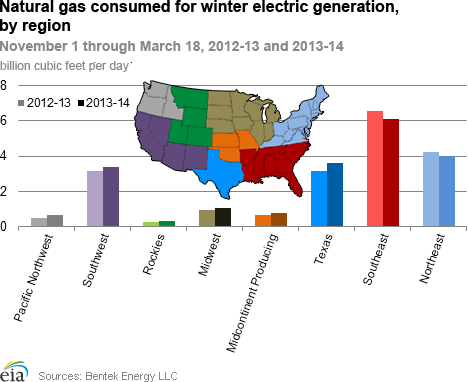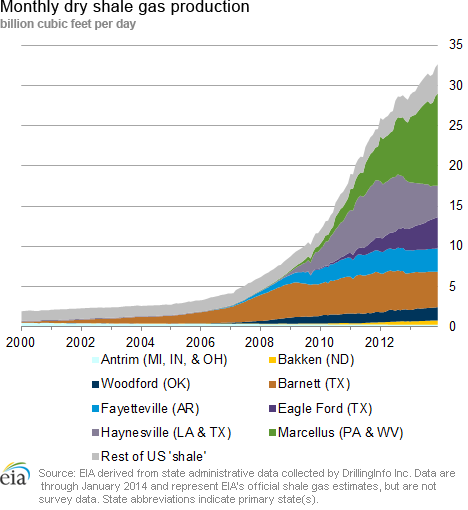In the News:
In the News: Growth in central and western U.S. drives increase in winter power burn
Colder temperatures this winter in the United States led to increased demand for natural gas from the electric power sector, as more natural gas-fired generation was needed to heat homes and businesses. From November 1, 2013, to March 18, 2014, daily temperatures in the 48 contiguous states averaged 41 degrees Fahrenheit, 7% colder than the same period last winter, according to data from Bentek Energy. Average power burn through March 18 rose by 2% over last winter's level, from 19.5 billion cubic feet per day (Bcf/d) to 19.9 Bcf/d.
However, while temperatures declined almost uniformly throughout the 48 contiguous states, there was no uniformity for the increase in power burn. Colder temperatures increased the demand for natural gas across all sectors, but the accompanying record-high natural gas storage withdrawals and higher prices also placed counterbalancing downward pressure on power burn. This was particularly true in the eastern United States, where as a result of periods of sustained higher prices, average power burn declined compared with last winter. To a lesser degree, natural gas prices rose in the central and western United States. However, despite the year-over-year price increases, power burn grew in these regions, driving the entire 48 contiguous states' increase.
Decreased power burn in the eastern United States In the Northeast and Southeast (shown in map above), electric sector consumption of natural gas declined by a combined 0.6 Bcf/d this winter, 6% below last winter's power burn for these regions through March 18.
- In the Southeast, power burn declined by 0.4 Bcf/d, or 6%, compared with last winter. The average national benchmark spot price at Henry Hub in Erath, Louisiana, increased by 36% over last winter to $4.65 per million British thermal units (MMBtu), according to data from SNL Energy. Through the end of 2013, many states in the Southeast offset lower levels of natural gas-fired generation with decreased total power consumption, increased nuclear power generation, and increased hydroelectric power generation, according to data from EIA's most recent Electric Power Monthly.
- In the Northeast, average natural gas power burn decreased this winter by 0.2 Bcf/d, or 5%, compared to the 2012-13 winter, according to Bentek data. Electric generators in the Northeast paid the country's highest spot prices for natural gas. This was particularly true for coastal states in the Northeast, where increased consumption of firm, contracted gas from local distribution companies (LDCs) during periods of high weather-driven demand limited the amount of pipeline capacity available to power companies. This scenario often leads to price spikes that drive up costs for electric generators.
Increased power burn in the central and western United States While higher natural gas prices likely limited the amount that natural gas power burn rose in response to colder temperatures this winter in the central and western United States, their impact on power burn was not as pronounced as in the Northeast and Southeast. Power burn in the central and western regions rose by 1.1 Bcf/d, or 12%, through March 18, 2014 over last winter's levels, driving the entire Lower 48 increase in power burn.
- The largest increase took place in Texas, where natural gas consumed for power burn increased by 0.4 Bcf/d, or 14%, over last winter's levels. Electric generators in Texas have met increased electric heating demand this past winter with a combination of increased wind generation, increased coal-fired generation, and increased gas-fired generation.
- Power burn rose by a combined 0.6 Bcf/d, or 11%, in the Midwest, Midcontinent producing, Pacific Northwest, Rockies, and Southwest regions. Cold temperatures in the Midwest pushed up natural gas power burn there, even as coal-fired power generation increased through 2013. Natural gas power burn also rose in the Pacific Northwest and Southwest to meet cold weather-driven electric demand, and to compensate for lower levels of hydroelectric generation.
Overview:
(For the Week Ending Wednesday, March 19, 2014)
- Spot prices fell at most market locations during the report week (Wednesday, March 12, to Wednesday, March 19) as demand declined from the strong weather-related levels of the previous week. The Henry Hub spot price fell from $4.66 per million British thermal units (MMBtu) last Wednesday to $4.44/MMBtu yesterday.
- At the New York Mercantile Exchange (Nymex), the April 2014 contract posted almost zero net change, decreasing slightly from $4.490/MMBtu at the beginning to the report week to $4.484/MMBtu yesterday.
- Working natural gas in storage fell to 953 Bcf as of Friday, March 14, according to the U.S. Energy Information Administration (EIA) Weekly Natural Gas Storage Report (WNGSR). A net storage withdrawal of 48 Bcf for the week resulted in storage levels 49.4% below year-ago levels and 47.9% below the 5-year average.
- The total rig count was 1,809 as of March 14, according to data from Baker Hughes Inc. The natural gas rotary rig count totaled 344, which represents a decrease of 1 rig from the previous week and a decrease of 87 units from the same time last year. Oil rigs rose for the fifth week in a row, by 18 units to 1,461, which is 120 greater than last year at this time.
- The weekly average natural gas plant liquids composite price decreased for the sixth week in a row this week (covering March 10 through March 14), by 0.7%, and is now at $10.08/MMBtu. This is more than $2.50/MMBtu less than at the end of January, when the composite price was $12.69/MMBtu. The price of ethane decreased by 5.1%, while the price of propane decreased for the fifth week in a row, by 0.6%. Butane and isobutane prices declined by 0.3% and 0.4%, respectively, and natural gasoline prices rose 1.9%.
Prices/Demand/Supply:
Henry Hub price falls. The Henry Hub spot price declined to $4.44/MMBtu this week, as weather became milder near the end of the report week. Price patterns were similar in most other parts of the country, as temperatures finally seem to be approaching moderation after a winter characterized by frigid temperatures and near record-breaking snowfalls in several major cities.
Chicago price trades closer to Henry Hub. The price at the Chicago Citygate historically trades very close to the Henry Hub price and is generally only 10 to 20 cents greater than the spot price at Henry Hub. This winter, however, the spread between the two price series significantly increased, likely due to frigid cold and pipeline constraints that affected the Midwest much more than the Gulf Coast. On trade date February 28, for example, the Chicago price settled at $36.27/MMBtu, more than $31/MMBtu greater than the Henry Hub. The Chicago price has remained elevated over the Henry Hub price since January; however, the spread has narrowed in the past few weeks. On average, the Chicago Citygate price was 37 cents/MMBtu greater than the Henry Hub price this week, compared to $1.60/MMBtu last week and $13.60/MMBtu the previous week. Chicago Citygate prices fell this week from $5.29/MMBtu at the beginning of the report week to $4.72/MMBtu yesterday.
Northeast prices rise mid-week. Temperatures were up and down over the report week in the Northeast and Mid-Atlantic, and prices reflected this. Frigid temperatures at the beginning of the report week were followed by sunny, warm weather over the weekend, and then more cold and snow in some regions Sunday night into Monday. At Transco Zone 6's trading point for New York City delivery, prices began the week at $21.95/MMBtu, fell to $5.22/MMBtu on Thursday, then rose to $8.05/MMBtu Friday, likely anticipation of winter weather coming on Sunday and Monday. By the end of the report week, prices at Transco Zone 6 New York had dropped back to the mid-$4/MMBtu range.
Nymex prices remain in the mid-$4/MMBtu range. The Nymex near-month (April 2014) contract opened the report week at $4.49/MMBtu last Wednesday and settled yesterday at $4.484/MMBtu, though there were a few mid-week increases and declines. The 12-month strip (the 12 contracts between April 2014 and March 2015) fell slightly from $4.54/MMBtu last Wednesday to $4.521/MMBtu yesterday.
Consumption increases week over week. Total consumption increased 5.2% week over week, with increases occurring in all sectors. In the residential and commercial sectors, which primarily use natural gas for heating, demand was highest last Wednesday and Sunday-Monday, the coldest days of the week. Overall residential and commercial consumption rose 7.4% this week. Consumption of natural gas for power generation increased 6.2%, and industrial consumption rose 0.9%.
Total supply increases. Total supply increased 0.3% this week, as increases in domestic production and flows to the Northeast from Canada offset declines in Canadian natural gas imports into the West and Midwest. Flows of gas from Canada into the Northeast rose 44.8% week over week, and last Thursday totaled 1.8 Bcf, their highest level since the end of January. These flows fell the next day and averaged 1.0 Bcf/d the rest of the week.
Storage
Warmer weather brings a larger-than-average net withdrawal. The net withdrawal reported for the week ending March 14 was 48 Bcf, 18 Bcf larger than the 5-year average of 30 Bcf, but 26 Bcf smaller than last year's net withdrawal of 74 Bcf. Working gas inventories totaled 953 Bcf, 932 Bcf (49.4%) less than last year at this time, 876 Bcf (47.9%) below the 5-year (2009-13) average, and 662 Bcf (41.0%) below the 5-year minimum.
Storage draw falls below market expectations of 59 Bcf. When the EIA storage report was released at 10:30 a.m., the price for the April natural gas futures contract fell 4 cents to $4.39 /MMBtu on the Nymex. Prices fell an additional cent in the hour following the release.
Two of the three regions posted larger-than-average builds. The East, West, and Producing regions had net withdrawals of 35 Bcf (4 Bcf larger than its 5-year average withdrawal of 31 Bcf), 2 Bcf (1 Bcf smaller than its 5-year average withdrawal of 3 Bcf), and 11 Bcf (compared with its 5-year average injection of 5 Bcf), respectively. Storage levels for all three regions remain below their year-ago and 5-year average levels, and their 5-year minimums.
Temperatures during the storage report week warmer than normal. Temperatures in the Lower 48 states averaged 43.9 degrees for the week, 1.0 degree warmer than the 30-year normal temperature and 0.6 degree warmer than during the same period last year.
See also:
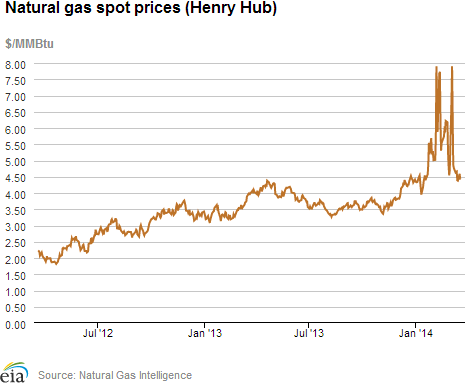
| Spot Prices ($/MMBtu) | Thu, 13-Mar |
Fri, 14-Mar |
Mon, 17-Mar |
Tue, 18-Mar |
Wed, 19-Mar |
|---|---|---|---|---|---|
| Henry Hub |
4.39 |
4.38 |
4.59 |
4.44 |
4.44 |
| New York |
5.22 |
8.05 |
5.93 |
4.77 |
4.45 |
| Chicago |
4.61 |
4.92 |
4.69 |
4.86 |
4.72 |
| Cal. Comp. Avg,* |
4.52 |
4.47 |
4.72 |
4.63 |
4.65 |
| Futures ($/MMBtu) | |||||
| April Contract |
4.383 |
4.425 |
4.456 |
4.456 |
4.484 |
| May Contract |
4.355 |
4.403 |
4.424 |
4.424 |
4.458 |
| *Avg. of NGI's reported prices for: Malin, PG&E citygate, and Southern California Border Avg. | |||||
| Source: NGI's Daily Gas Price Index | |||||
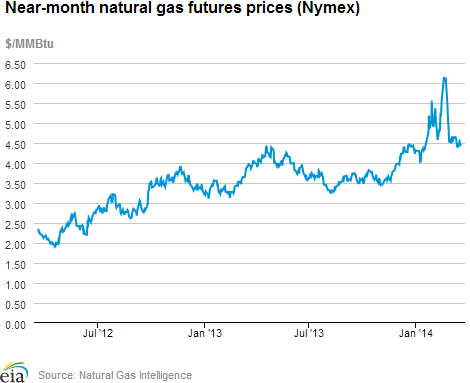
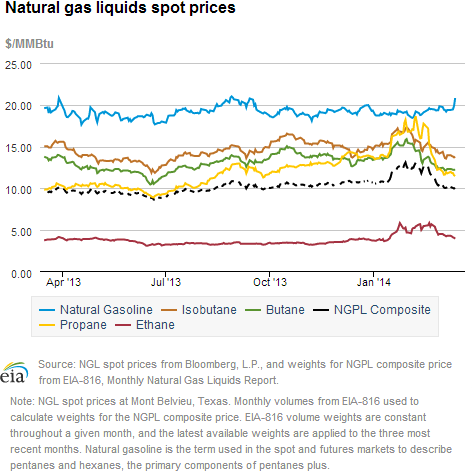
| U.S. Natural Gas Supply - Gas Week: (3/12/14 - 3/19/14) | ||
|---|---|---|
Percent change for week compared with: |
||
last year |
last week |
|
| Gross Production | 4.00%
|
0.13%
|
| Dry Production | 3.96%
|
0.13%
|
| Canadian Imports | -3.68%
|
4.45%
|
| West (Net) | -6.37%
|
-1.06%
|
| MidWest (Net) | -8.63%
|
-7.91%
|
| Northeast (Net) | 10.06%
|
44.84%
|
| LNG Imports | N/A
|
N/A
|
| Total Supply | 3.10%
|
0.31%
|
| Source: BENTEK Energy LLC | ||
| U.S. Consumption - Gas Week: (3/12/14 - 3/19/14) | ||
|---|---|---|
Percent change for week compared with: |
||
last year |
last week |
|
| U.S. Consumption | 0.9%
|
5.2%
|
| Power | -6.2%
|
6.2%
|
| Industrial | 1.5%
|
0.9%
|
| Residential/Commercial | 4.1%
|
7.4%
|
| Total Demand | 0.9%
|
5.3%
|
| Source: BENTEK Energy LLC | ||
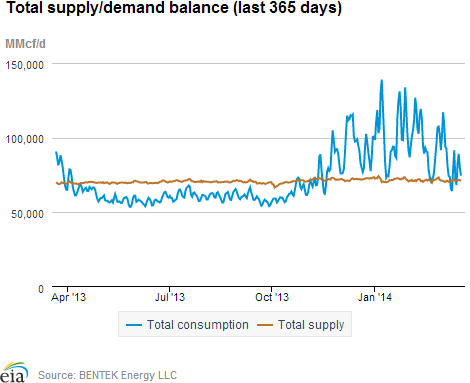
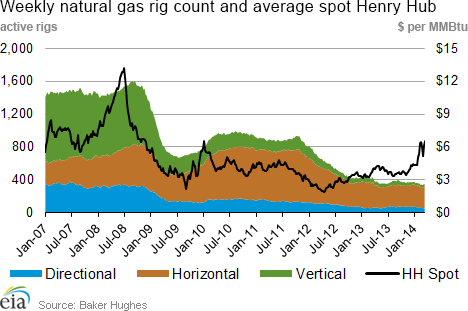
| Rigs | |||
|---|---|---|---|
Fri, March 14, 2014 |
Change from |
||
last week |
last year |
||
| Oil Rigs | 1,461 |
1.25% |
8.95% |
| Natural Gas Rigs | 344 |
-0.29% |
-20.19% |
| Miscellaneous | 4 |
0.00% |
0.00% |
| Rig Numbers by Type | |||
|---|---|---|---|
Fri, March 14, 2014 |
Change from |
||
last week |
last year |
||
| Vertical | 393 |
0.26% |
-9.86% |
| Horizontal | 1,212 |
0.83% |
7.16% |
| Directional | 204 |
3.03% |
-2.39% |
| Source: Baker Hughes Inc. | |||
| Working Gas in Underground Storage | ||||
|---|---|---|---|---|
Stocks billion cubic feet (bcf) |
||||
| Region | 2014-03-14 |
2014-03-07 |
change |
|
| East | 395 |
430 |
-35 |
|
| West | 167 |
169 |
-2 |
|
| Producing | 391 |
402 |
-11 |
|
| Total | 953 |
1,001 |
-48 |
|
| Source: U.S. Energy Information Administration | ||||
| Working Gas in Underground Storage | |||||
|---|---|---|---|---|---|
Historical Comparisons |
|||||
Year ago (3/14/13) |
5-year average (2009-2013) |
||||
| Region | Stocks (Bcf) |
% change |
Stocks (Bcf) |
% change |
|
| East | 790 |
-50.0 |
794 |
-50.3 |
|
| West | 339 |
-50.7 |
293 |
-43.0 |
|
| Producing | 756 |
-48.3 |
742 |
-47.3 |
|
| Total | 1,885 |
-49.4 |
1,829 |
-47.9 |
|
| Source: U.S. Energy Information Administration | |||||
| Temperature -- Heating & Cooling Degree Days (week ending Mar 13) | ||||||||
|---|---|---|---|---|---|---|---|---|
HDD deviation from: |
CDD deviation from: |
|||||||
| Region | HDD Current |
normal |
last year |
CDD Current |
normal |
last year |
||
| New England | 226
|
12
|
41
|
0
|
0
|
0
|
||
| Middle Atlantic | 203
|
3
|
34
|
0
|
0
|
0
|
||
| E N Central | 223
|
12
|
17
|
0
|
0
|
0
|
||
| W N Central | 190
|
-21
|
-44
|
0
|
-1
|
0
|
||
| South Atlantic | 112
|
-9
|
-9
|
7
|
-3
|
2
|
||
| E S Central | 104
|
-10
|
-24
|
0
|
-4
|
0
|
||
| W S Central | 80
|
9
|
3
|
3
|
-7
|
-1
|
||
| Mountain | 131
|
-34
|
-29
|
2
|
1
|
1
|
||
| Pacific | 50
|
-43
|
-38
|
0
|
-1
|
0
|
||
| United States | 150
|
-9
|
-4
|
2
|
-2
|
0
|
||
|
Note: HDD = heating degree-day; CDD = cooling degree-day Source: National Oceanic and Atmospheric Administration | ||||||||
Average temperature (°F)
7-Day Mean ending Mar 13, 2014
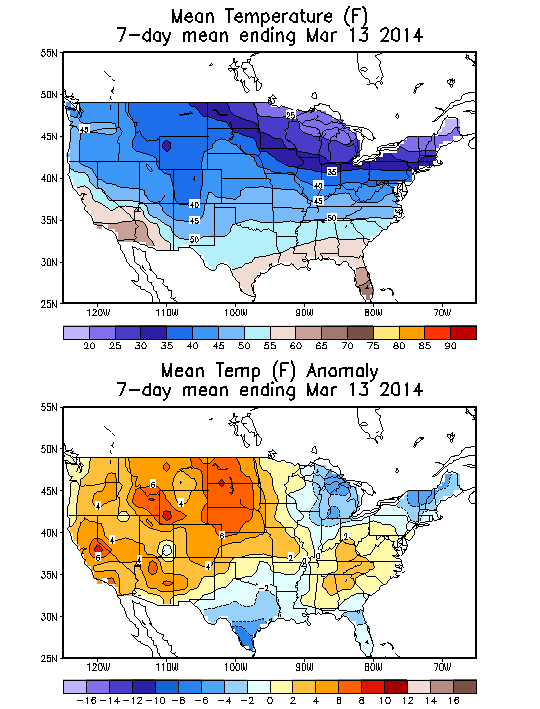
Source: NOAA/National Weather Service
Deviation between average and normal (°F)
7-Day Mean ending Mar 13, 2014

Source: NOAA/National Weather Service

